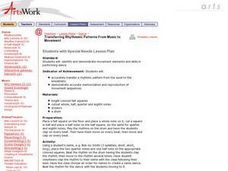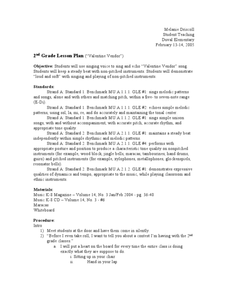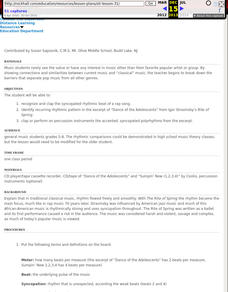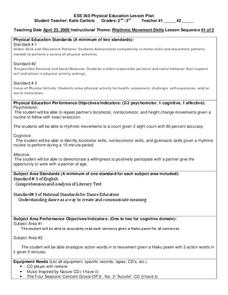Curated OER
Music and Emotion
Students identify the various emotions created by different types of music. They Identify role of music in creating various emotions for film and television . They observe and practice various ways of playing percussion instruments. They...
Curated OER
Music Lesson Plan for Teaching Children with (Severe) Autism
Here's a packet of music activities designed specifically for children with autism. Kids learn greeting, echo, and repertory songs, as well as rhythmic patterns to play rhythm instruments.
Curated OER
RHYTHMIC PATTERNS
Students explore rhythmic patterns. They create and perform the rhythms and use Cubase software to perform, record, and play rhythms for use in dictation exercises. They identify and count rhythm patterns
Curated OER
Transferring Rhythmic Patterns From Music to Movement
Students identify and demonstrate movement elements in relation to musical notation. They clap to rhythms, beat on drums, match musical notes to speech patterns and use the rhythms of the their names to create a dance.
Curated OER
Jewish Folk Song: Ya Ba Bom
Singing is a wonderful way to express an idea of any kind. This lesson is written expressly for use in directing a high school chorus. They work on using four-part harmony, expression, and melodic intervals while singing a Jewish folk...
Curated OER
Rhythmic Pattern and Movement
Learners practice repeating rhythmic patterns in unison. Next, students work in groups to practice an alternate rhythmic pattern to Row, Row, Row Your Boat. They create their own rhythmic patterns for the song.
Curated OER
Math, Fractions, and Music
Students discover the relationship between musical rhythms and fractions. They add musical notes together to produce fractions and create addition and subtraction problems with musical notes. Students complete worksheets and create their...
Curated OER
Using Rhythm to Teach Patterns and Directions
Introduce young learners to line dancing. Here are some simple movement patterns to teach them. First teach, repeat, and repeat again without music. Then when they have a pretty good grasp of the movement patterns, add music and practice...
Curated OER
Grade 2: Music/Valentine's Day
Play and sing a Valentine's song with your second graders. They'll follow along allow as you demonstrate how to sing and keep a steady beat on non-pitched percussive instruments. While the music lesson has a Valentine theme, that theme...
Curated OER
Hispanic Rhythmic Patterns and Drums
Students imitate rhythmic patterns created by the teacher or taken from the drum performance of "Oshossi." They study and perform some of the layered and interlocking rhythms of the drum ensembles of Brazil, Haiti, Cuba, Suriname, and...
Berklee College of Music
Create Your Own Afro-Latin Groove
The backbone of Latin American music is the beat! Young musicians work on blending Afro-Latin rhythms and beat patterns before incorporating the major pentatonic, minor pentatonic, and blues scales in their own compositions.
Curated OER
Kodaly Beat Lesson
Introduce rhythmic beat and melodic beat with a upbeat activity that asks young musicians to clap the beat to their favorite nursery rhyme. To introduce the rest beat, class members use small drums or other percussion instruments to play...
Curated OER
Rhythmic Pattern and Expressive Movement
Students use the song Row Row Row Your Boat to help them learn patterns and expressive movement. They recreate the movement over and over until it is a pattern and they feel comfortable doing it.
Curated OER
Learning Different Rhythmic Patterns
Fifth graders observe and demonstrate different rhythmic patterns including combinations of quarter and rest notes. They discuss how rhythm is created by using quarter and rest notes, clap to a rhythmic pattern, write a rhythm, and...
Curated OER
Syncopation and Rhythm in Igor Stravinsky's Rite of Spring and Rap Music
Students recognize and clap the syncopated rhythmic beat of a rap song and identify recurring rhythmic pattern in the excerpt of "Dance of the Adolescents" from Igor Stravinsky's Rite of Spring.
Curated OER
Learning AB Form: Music
Third grade musicians play Orff instruments while they learn about the AB Form. First they learn part A of a song, then they listen to when the song changes. After they understand the concept of AB form, they learn to play part B. Note:...
Curated OER
Using Garage Band to Enhance 2nd Grade Composition
Your second graders can become composers with a little help from the Garage Band software. You pre-select several drum, piano, and guitar loops for the groups to choose from, then they put them together following an ABA looping pattern....
Curated OER
It Just Keeps Going and Going...
Students explore patterns, identify patterns, and complete a variety of patterns. They view and discuss an online video and identify the different patterns from the film, then using a hundreds grid create an original pattern using their...
Curated OER
Learning Refrain and Verse
Instruct your young musicians on the terms verse and refrain. They listen to two songs, and point out the verse and refrain as they occur. Students then play drums when they hear the verse and the refrain. Note: Song lyrics, sheet music,...
Curated OER
Rhythmic Movement Skills
Young scholars explore rhythmic movements. In this performing arts lesson, students create their own movements and then repeat the each others movement. Finally, young scholars create movements to the Haiku generated by the entire class.
Curated OER
Rhythmic Travel Around the World
Pupils explore and play rhythm sticks while listening to songs from around the world. They locate the countries of origin on a map, and tap their rhythm sticks to the beat of the music.
Curated OER
Balance and Rhythmic Movement Skills
Students balance and move rhythmically. In this music lesson students use a balance beam moving in different ways and participate in a rhythmic activity moving to music. The students use ribbons moving to the music.
Curated OER
Rock Till You Drop!
Students study rhythmic patterns and phrases on percussion instruments. They form a drum circle and take turns playing the beat. After listening to styles of rhythms, students compare styles of music. They compose a short piece of...
Curated OER
Say It Loud!: A Celebration Of Black Music in America - Lesson 4
Learners choose a theme for a song. They compose a poem, and write music to go along with their poem. The instructor plays the musical accompaniment, and the class votes on the most appropriate rhythmic pattern.























